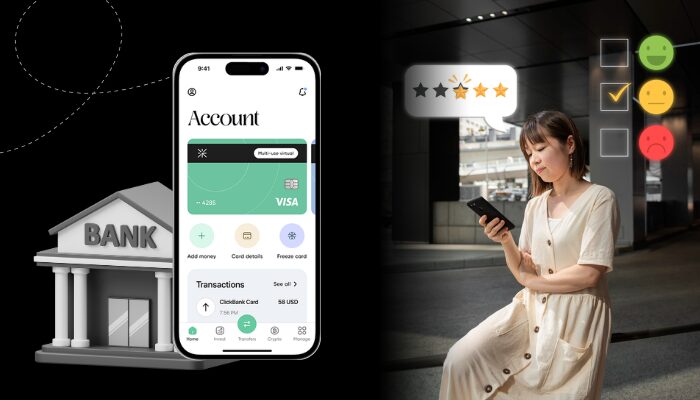Crucial Role of Customer Feedback in Banking App Development

In the fast-evolving landscape of digital banking, customer feedback serves as a vital compass for developers and financial institutions alike. Banking apps are not merely tools for transactions; they are portals through which users manage their finances, monitor investments, and interact with their banks. The effectiveness and usability of these apps directly impact user satisfaction and loyalty.
Here’s a comprehensive exploration of how customer feedback influences and shapes the development of banking apps, spanning 11 crucial roles.
Ø Identifying Bugs and Technical Issues
One of the primary roles of customer feedback in developing a banking app is identifying bugs and technical issues. Users often encounter glitches while performing transactions, accessing account information, or navigating the app’s interface.
When users report these issues through feedback channels, developers gain critical insights into the app’s performance under real-world conditions. Prompt identification and resolution of bugs not only improve user experience but also prevent potential security vulnerabilities.
This is why it is important to consider an experienced banking app development company that emphasizes fixing issues.
Ø Enhancing User Experience
Customer feedback provides developers with valuable insights into user experience (UX). Users express preferences regarding navigation, design aesthetics, ease of use, and the overall intuitiveness of the app.
By analyzing this feedback, developers can implement changes that enhance the app’s usability, streamline workflows, and ensure a seamless experience across different devices and platforms.
Iterative improvements based on user feedback contribute to higher user satisfaction and increased app engagement.
Ø Prioritizing Feature Development
User feedback plays a crucial role in prioritizing feature development. Users often suggest new features or improvements that align with their financial management needs and expectations.
By aggregating and analyzing these suggestions, developers can prioritize the implementation of features that are most requested or beneficial to a significant portion of their user base.
This iterative process ensures that banking apps remain competitive and meet evolving user demands.
Ø Continuous Improvement and Iterative Development
Customer feedback drives a culture of continuous improvement and iterative development in banking app. Unlike traditional software development cycles, which may have lengthy release cycles, banking apps benefit from agile methodologies that allow for rapid iterations based on user feedback.
This agile approach enables developers to release updates more frequently, incorporating user suggestions, bug fixes, and performance enhancements in shorter cycles.
Building a secure and feature-rich banking app affects the significant development cost of a banking app, but the long-term benefits can outweigh the costs.
Ø Performance Optimization
Performance issues like slow loading times, transaction lags, or app crashes can really frustrate you when you’re trying to manage your finances on the go. When these problems occur, they disrupt everyone’s experience and make you hesitant to rely on the app for important transactions. However, user feedback is crucial in helping developers pinpoint these performance bottlenecks and technical limitations that affect how responsive the app is.
Ø Security and Privacy Enhancements
Security is absolutely critical when it comes to banking apps, and you want to feel confident that your financial information is always protected. That’s why user feedback is so valuable—it gives developers insights into any security vulnerabilities or concerns you might have.
Whether you’re worried about account protection, data encryption, or potential unauthorized access your input helps developers prioritize security enhancements based on these insights, implementing robust measures to safeguard user data and transactions.
Proactive responses to security feedback mitigate risks and strengthen the app’s reputation for reliability and trustworthiness.
Ø Personalization and Customization Options
Personalization features allow users to tailor their banking experience according to their preferences and financial habits.
Customer feedback helps developers understand user expectations regarding customization options such as personalized dashboards, account settings, and notification preferences.
By integrating requested personalization features, developers empower users to interact with the app in a way that reflects their individual financial goals and priorities. This customization enhances user satisfaction and loyalty.
Ø Compliance with Regulatory Standards
Banking apps must comply with stringent regulatory standards and data protection laws to ensure legal compliance and maintain user trust.
Customer feedback may highlight concerns related to regulatory compliance, privacy policies, or data handling practices. Developers use this feedback to align app features and functionalities with industry regulations, implementing necessary updates and disclosures.
Adherence to regulatory standards not only mitigates legal risks but also enhances the app’s credibility and transparency.
Ø User Engagement and Retention Strategies
Effective user engagement is essential for app success and user retention. Customer feedback provides insights into user engagement metrics, including feature usage patterns, frequency of app interactions, and user satisfaction levels.
Developers leverage this feedback to devise strategies that enhance user engagement, such as gamification elements, loyalty rewards, or educational content. By fostering meaningful interactions and responding to user preferences, developers cultivate a loyal user base that actively participates in the app ecosystem.
Ø Competitive Advantage and Market Differentiation
In a competitive fintech landscape, customer feedback can catalyze innovation and market differentiation. Apps that listen attentively to user feedback and swiftly implement requested features gain a competitive edge.
User-driven innovation ensures that banking apps remain relevant and responsive to evolving consumer preferences. By continuously improving features and functionalities based on user insights, developers position their app as a leader in the market, attracting new users and retaining existing ones.
Ø Building Trust and Reputation
Trust is foundational in banking relationships, and customer feedback plays a pivotal role in building and maintaining trust. When users see their feedback translated into tangible improvements or resolutions, it demonstrates that their opinions are valued and their concerns are taken seriously.
Also, transparent communication about app updates, security measures, and user-centric features fosters trust and strengthens the app’s reputation. A trustworthy app encourages user confidence in financial transactions and reinforces loyalty to the banking institution.
Conclusion
Customer feedback is not merely a source of insights but a driving force behind the evolution and success of banking apps. By listening attentively to user experiences, preferences, and concerns, developers can create apps that are secure, user-friendly, and aligned with regulatory requirements. The iterative process of gathering feedback, implementing improvements, and measuring outcomes ensures continuous innovation and enhancement of app features. Ultimately, banking apps that prioritize customer feedback are poised to deliver exceptional user experiences, foster long-term relationships, and thrive in a competitive digital marketplace.
As users, your feedback shapes the future of banking technology. Your insights and suggestions contribute to the development of apps that empower you to manage your finances efficiently and securely. Keep providing feedback, and together, we can continue to refine and improve banking apps that meet the diverse needs of users worldwide.





